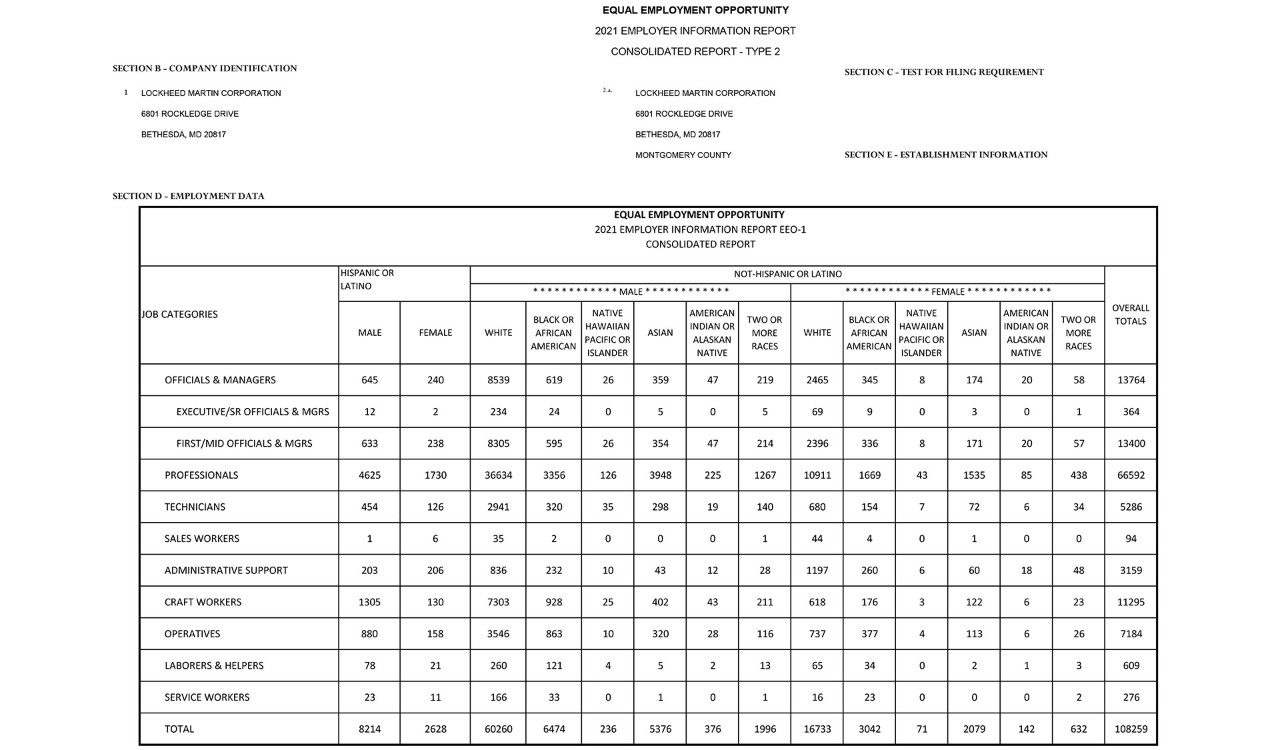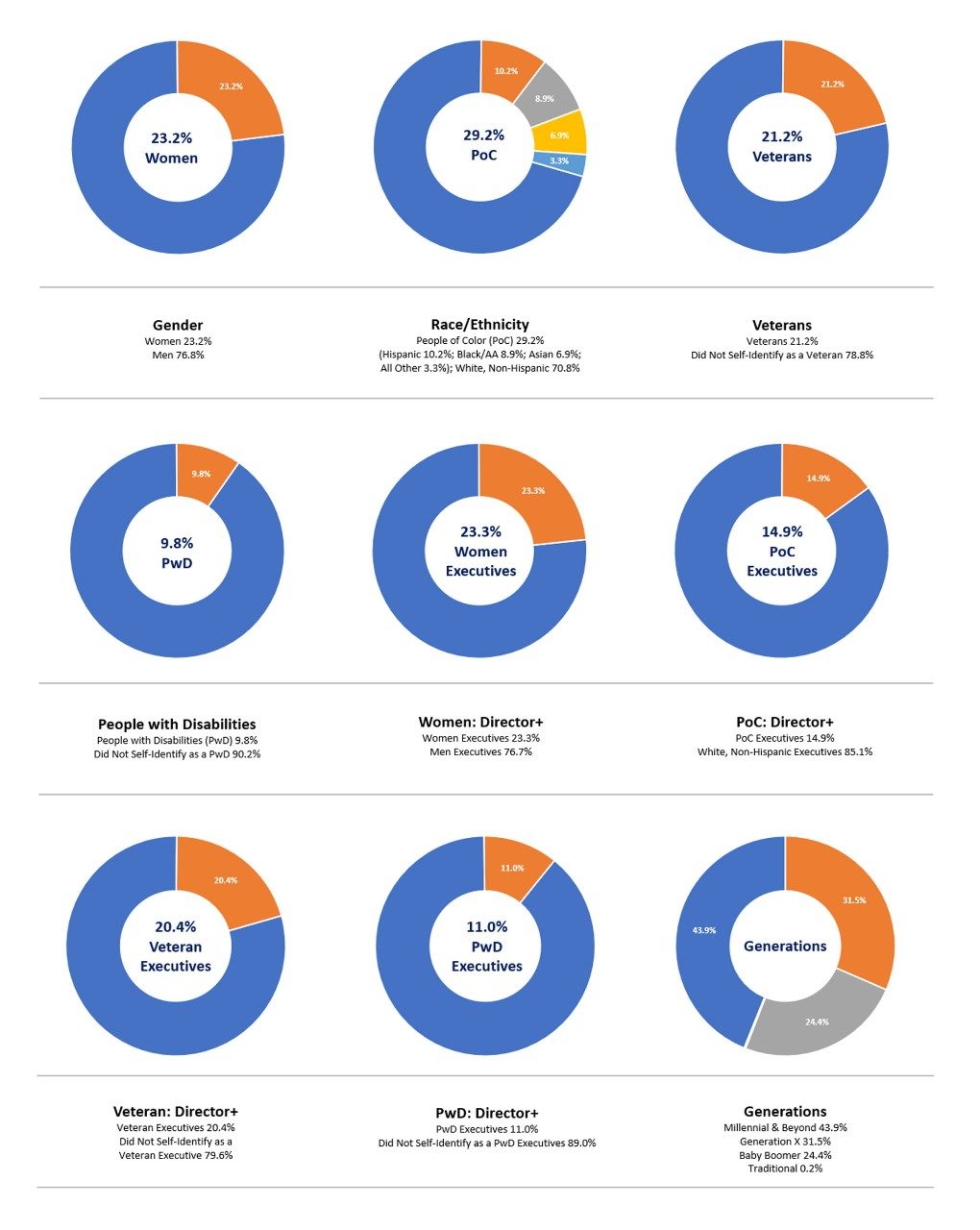EEO-1 Reporting
Lockheed Martin, as a federal contractor meeting certain criteria, is required to annually submit demographic workforce data to the U.S. government. The Employer Information Report, otherwise known as the EEO-1 Report, includes data about our U.S. based workforce by gender, ethnicity and race and by job categories. The ten job categories listed in the Report are based on the U.S. Department of Labor’s Job Classification Guide, which is based on the 2018 Standard Occupational Classification (SOC) and Census Job Codes and Titles, regardless of industry.
The EEO-1 Report data is one measure of our progress toward a more diverse and inclusive U.S. workforce within Lockheed Martin. While the job categories in the EEO-1 Report are quite broad and do not directly align with our functional organizations or job classification structure, the Report provides insight into the diversity of the company’s U.S. population overall.
Publication of our EEO-1 information is a positive step toward transparency, expanding our awareness of our workforce demographics, and supporting further discussions around representation.
Comparison to External Benchmarks
Lockheed Martin’s U.S. data can be compared to external benchmarks, such as other Aerospace and Defense (A&D) companies or independent standards, to determine how well we are doing. Some may compare it against companies in other industries that reflect bona fide differences in the composition of the workforces, based on the services, industries and types of occupations each company employs.
For example, a U.S. health care organization may have a large, even majority, female workforce, based on the occupations it employs, such as nurses and health care workers, as women comprise 89.4% of the registered nurses and 71.8% of medical and health services managers in the U.S., per U.S. Census data. Similarly, registered nurses are 27.5% People of Color, and medical and health services managers are 28.6% People of Color.
In comparison, as an A&D contractor, over half of Lockheed Martin's U.S. workforce is employed in science, technology, engineering and math (STEM) occupations. Example positions in the STEM occupations and their nationwide female availability are: aerospace engineer (12.6%), software developer (21.9%), and mechanical engineer (8.4%). The U.S. Census demographic composition of the occupations employed at Lockheed Martin is 26.3% women, 73.7% men, 35.4% People of Color and 64.6% White.
In this example, women comprise more than 70% of the healthcare organization’s occupations but only 26.3% of the occupations employed by Lockheed Martin. The gender composition of the two workforces differ, based on the occupations employed.
Additionally, although U.S. citizens and non-citizens are counted in the U.S. Census data, only citizens are eligible to obtain U.S. government granted security clearances. On average, 70% of Lockheed Martin’s open positions require a security clearance, and this U.S. Government requirement limits the workforce available to Lockheed Martin. The limitation is relevant when comparing Lockheed Martin to high tech firms or A&D companies with significant commercial business, which do not have similar needs for cleared workforces.
As shown in the 2021 ESG Performance Index, since 2018 Lockheed Martin has increased the representation of women in the U.S. workforce from 22.6% to 23.2% and People of Color representation from 26.0% to 30.0%, as of July 31, 2022, showing some progress from the December 31, 2021 data shown above. We are currently within two percentage points of the 2021 Aerospace and Defense Workforce Study representation benchmark of women at 24.8% in our industry, and are currently at the Study’s People of Color representation benchmark of 30%.
While we’ve made progress, we know that we still have work to do, which is why we actively engage in numerous activities to make a more diverse and inclusive workplace for our current and potential future employees, many of which are highlighted here: Lockheed Martin Global Diversity and Inclusion. We look forward to continuing to appropriately increase the demographic diversity of our workforce as U.S. representation is one measure of our overall progress toward a more diverse and inclusive workplace.
Updated: September 2, 2022





